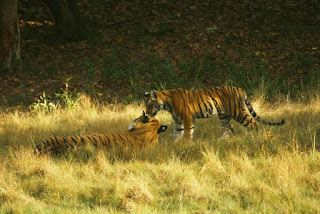"When they do not want to be seen you don't see them." I explained to my friend who had just been to Tadoba. "Yeah that's what happened at Tadoba," my friend replied back. We were very hopeful that he and his family would see the tiger there since it was so much in picture. There had been frequent tiger sightings at Tadoba in Maharashtra, surpassing the Central Indian Tiger Reserves.
Well I had warned them about the rains that could disrupt tiger safaris at the end of the season. That's what happened. It rained at both places and the safari was ruined. My friend was more hopeful at Pench with me along. He knows that I conduct tiger safaris and birding trips. But tigers are tigers unpredictable yet fathomable.
In National Parks these big cats are seen whence stressed for water and food. Heat and the need to chalk out their territory time and again brings them near the jungle roads. Yes a search for a mate also fetches them into the open. But on rainy day they prefer to relax under the canopy, and have water all around. There is no need for thermo-regulation which keeps indolent. The prey base is scattered all around. But tigress with cubs are more likely to move. If the cubs are grown up they stray away, but keep in the vicinity of the mother. In such circumstances you should keep to the area of the family.
In National Parks these big cats are seen whence stressed for water and food. Heat and the need to chalk out their territory time and again brings them near the jungle roads. Yes a search for a mate also fetches them into the open. But on rainy day they prefer to relax under the canopy, and have water all around. There is no need for thermo-regulation which keeps indolent. The prey base is scattered all around. But tigress with cubs are more likely to move. If the cubs are grown up they stray away, but keep in the vicinity of the mother. In such circumstances you should keep to the area of the family.
Without tiger sightings, the long rides in the forest are not as disappointing as people think. It is the singular chase for tiger that dampens the whole excursion.
There is so much to experience, in these lovely forests, deers, monkeys, a sudden surprise - four Jackals on a kill. The birds are simply fantastic they are must watch even for those who are not bird watchers. The resplendent colors, the acrobatic flight and remarkable camouflage that surprises you no end.
There is so much to experience, in these lovely forests, deers, monkeys, a sudden surprise - four Jackals on a kill. The birds are simply fantastic they are must watch even for those who are not bird watchers. The resplendent colors, the acrobatic flight and remarkable camouflage that surprises you no end.
The massive bisons and the stately sambar peacefully foraging on long grasses is a wonderful sight to watch. Other life forms are an intrigue that thrills. A sloth bear ambling along and a leopard on prowl can be as exciting as a pack of wildlife chasing a deer and consuming it while still alive. Well that is how the nature works.
The tiger some of us did see on the trip. We decided to move to the part of the river banks which was frequented by a tigress with grown up cubs. Another jeep spotted a tiger few minutes before we reached the banks of Pench River. They left as soon as the animal vanished leaving us to look for the big cat. We could hear lots of alarm cries but the bushes were very thick.
We waited ahead in the direction of tiger walk but the animal had decided to change its course, I presumed. Hence I turned my binoculars towards the river and its bank. It was one roar that told me where the animal was. We headed back for some distance and then looked at the river bed through the clearing. All us were standing on the jeep seats to get a better view. (You are not allowed to get down from the jeep and you shouldn't.)
"There it is! I whispered and pointed in the direction. Only one or two could see the tiger moving fast towards the other bank. The roar continued as it vanished into the tall grasses and that was that. I could still picture the scene but the roar was more exciting. My friends also appreciated this event. 'The roar was frightening," they said. Well it was!












